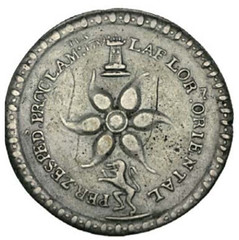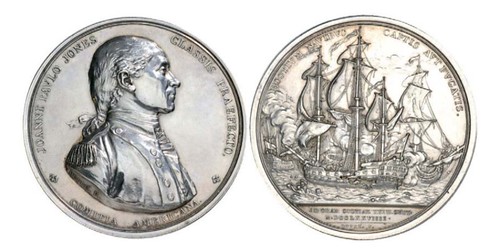
PREV ARTICLE
NEXT ARTICLE
FULL ISSUE
PREV FULL ISSUE
MEDALS IN THE MORTON & EDEN DECEMBER 2016 SALE
The December 2, 2016 sale of Coins and Historical Medals by Morton & Eden in London includes just five medals. Two of these are related to the U.S. Here are the lot descriptions.
-Editor
1789 East Florida Proclamation Medal 

Lot 786
The early Colonies of East and West Florida were originally ceded to Britain from Spain under the terms of the 1763 Treaty of Paris which ended the Seven Years’ War. Subsequently they were returned to Spain under the terms of the Treaty of Paris in 1783, which ended the American War of Independence. Soon afterwards Vicente Manuel Zespedes was installed as Governor of the newly returned colony; based at St Augustine, he previously held the position as Governor of nearby Santiago de Cuba in the preceding year. He attempted to increase the population and development of East Florida by luring former Spanish residents to return with the promise of land grants and 10-year tax exemptions, whilst also attempting to retain its British settlers, many of whom were by that time leaving for plantations in the islands of the British Caribbean. In anticipation of the planned proclamation of the new King Charles IV, commemorative medals (sometimes considered 4-real coins, which they resembled in terms of weight and size) were ordered in advance by Zespedes himself, probably being struck at his own personal expense, to be distributed during the celebrations due to take place on 2-4 December 1789. Three days of festivities followed, with processions, dancing, singing and military parades. It is here that Zespedes, leading the parade, is recorded as having cast handfuls of the newly made ‘silver money’ into the grateful crowd (with no mention of bronze), as recorded in an original letter dated December 9 1789 from Domingo Rodriguez de Leon, a notary based in St Augustine, to a correspondent in Spain regarding the details of the celebrations. Where, how many, and precisely how these pieces were made, however, remain elusive historical details. Studies concerning this medal have been made by several numismatists, but in particular by John W. Adams and also by Michael Hodder (as shown in the John Ford Jr Collection, Part XIII catalogue), and arguments have been made for the existence of 4 distinct types: struck silver, cast silver, after-cast silver re-issues, and after-cast bronze re-issues. Current theories regarding the place of manufacture vary, but some suggest Mexico City (where an official mint already existed) for the highest quality ‘struck’ examples, and then Havana, Santiago de Cuba or perhaps another local mint in Florida for the remainder, but no concrete documentary evidence exists to date. Given Zespedes’ links to Havana and Santiago and the relatively modest quality of the medals, a Cuban mint (probably at Havana) would seem most logical, as is also suggested by Hodder. Many of the “coins” were perhaps melted down later and consequently very few survive. Three ‘commemorative medals’ were reportedly sent by Zespedes to the king and a further three to the colonial secretary after the celebrations, and arguably these six medals could account for the supposedly ‘struck’ examples, with all others being cast as intended for general distribution. Nevertheless, it is worth pointing out that even the finest known ‘struck’ example, lot 660 in the John Ford Jr Collection (weighing 13.77g), shows clear casting flaws to the neck of the king’s portrait and in the medal’s fields – much the same as shown in the example offered here. The idea that the finest examples were struck on cast planchets whereas others were more simply cast has been suggested to explain the evident difference in quality. Perhaps the overall finish and craftsmanship used for the king’s & colonial secretary’s examples was of a higher standard - as one might expect and is known in other series. Such examples would have been unlikely to have entered circulation and would therefore have avoided wear. This argument would reduce the need for complex discussions regarding different issues being minted in different locations when the production appears to have been very much more a local one, which would have been under some considerable time pressure between the arrival of the news of Charles III’s death in Florida (March 1789) and the planned proclamation of Charles IV (December 1789). A further argument has been made regarding an apparent difference in legend for struck (TUS) and cast (TUR) examples in silver, but this does not seem to stand up to scrutiny, as each silver example illustrated in recent times appears to read TUS regardless. In Stack’s Bowers Auction, 26-31 March 2015 (lot 6002, the John W. Adams example weighing 11.61g), 5 silver examples were recorded. Thus the present piece appears to be the sixth known. A further three examples are known in bronze, giving a total of only nine presently known in any metal. In 1821, under the Adams-Onis Treaty, both Floridas were finally ceded to the United States who amalgamated the two to form the Territory of Florida the following year.
John Paul Jones - The Capture of the British Frigate H.M.S. Serapis 
Lot 787
On 23 September 1779 the U.S.S. Bonhomme Richard, under the command of Captain John Paul Jones, led a combined Franco-American fleet of 5 ships against a large Baltic merchant fleet being escorted by the British ships H.M.S. Serapis and the smaller Countess of Scarborough. The fighting took place off the Yorkshire coast near Flamborough Head and the coastal town of Bridlington, when the experienced French Captain Landais of the Alliance engaged and drew away the Countess of Scarborough, leaving Serapis to battle against the 4 remaining American and French ships. Initially the Serapis inflicted considerable damage to the hull and rigging of the Bonhomme Richard and the American flag fell, prompting Captain Richard Pearson of the Serapis to ask Jones if he had intentionally struck his colour in surrender. Jones defiantly replied: “I have not yet begun to fight!” and after a further three hours of bitter exchange it was indeed the Serapis and Countess of Scarborough which were forced to surrender. The Americans boarded and transferred across to the Serapis following a close, hard-fought victory, with the critically-damaged Bonhomme Richard sinking on the following day. The victory made John Paul Jones a national hero and this piece from the Comitia Americana series holds the distinction of being the only naval medal authorized by the Continental Congress.
For more information, or to bid, see:

Wayne Homren, Editor The Numismatic Bibliomania Society is a non-profit organization promoting numismatic literature. See our web site at coinbooks.org. To submit items for publication in The E-Sylum, write to the Editor at this address: whomren@gmail.com To subscribe go to: https://my.binhost.com/lists/listinfo/esylum All Rights Reserved. NBS Home Page Contact the NBS webmaster 
|